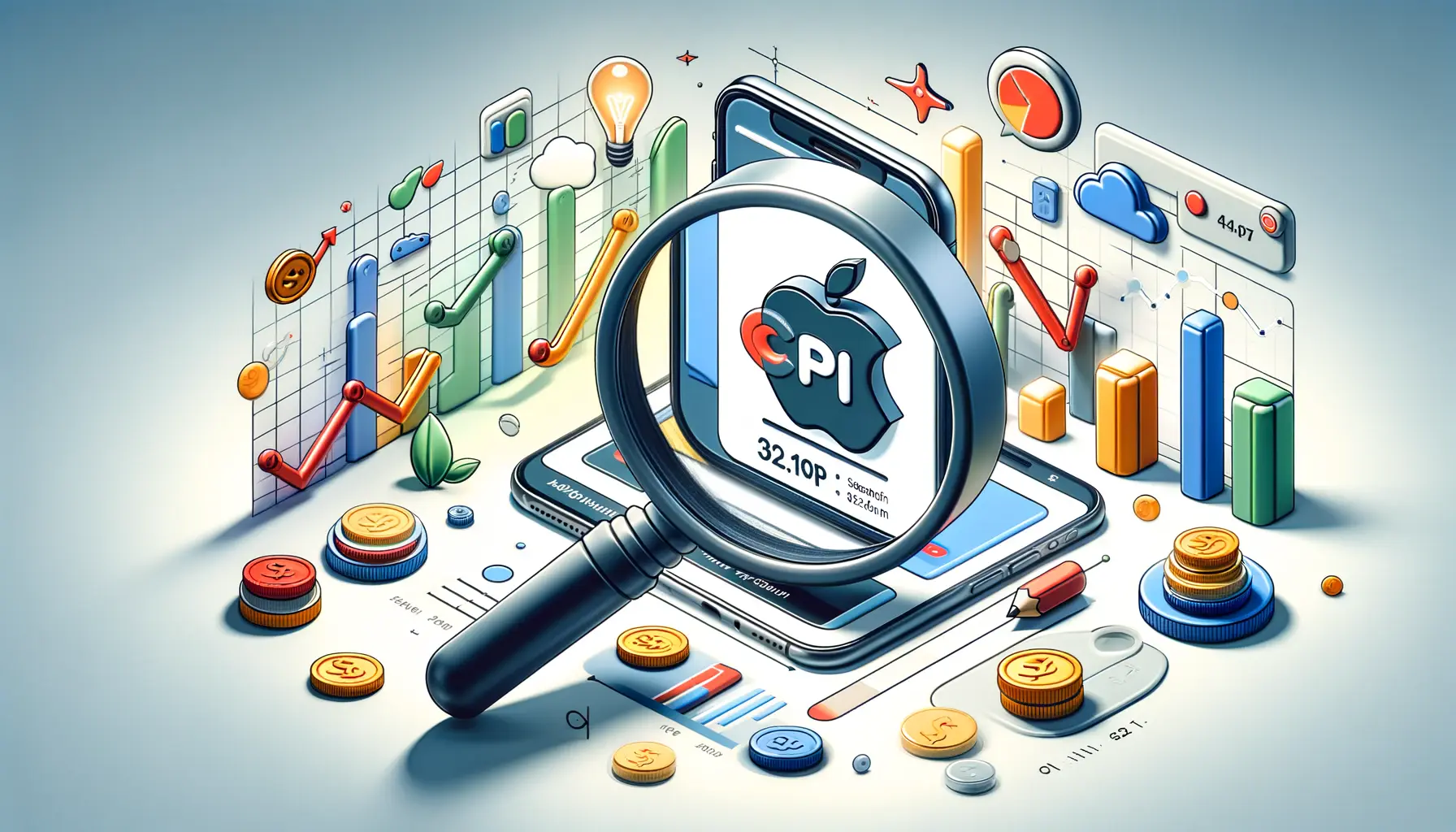In today’s digital age, advertising within Apple’s ecosystem has become a pivotal strategy for marketers aiming to reach a broad and engaged audience.
Apple, known for its stringent privacy policies and a user-centric approach, offers a unique platform for advertisers through Apple Search Ads.
This advertising avenue allows businesses to place their apps at the top of App Store search results, thereby increasing visibility and driving downloads.
The effectiveness of advertising on this platform, however, is closely tied to understanding and optimizing ads cost.
Ads cost in Apple’s ecosystem is not just about the financial outlay but also about strategizing for maximum return on investment (ROI).
With Apple’s Search Ads, advertisers can target potential customers with precision, thanks to Apple’s detailed user data.
However, navigating this ecosystem requires a deep understanding of cost management, bidding strategies, and the factors influencing ad performance.
This article delves into the intricacies of ads cost within Apple’s ecosystem, offering valuable insights for advertisers looking to capitalize on this powerful platform.
- Introduction to Apple Search Ads
- Key Factors Influencing Ads Cost
- Strategies for Optimizing Ad Spend
- Measuring and Analyzing Campaign Performance
- Advanced Targeting Techniques
- Utilizing Creative Assets Effectively
- Adapting to Apple’s Privacy Changes
- Mastering Ads Cost in Apple’s Ecosystem: A Strategic Blueprint
- FAQs on Ads Cost in Apple’s Ecosystem
Introduction to Apple Search Ads
Apple Search Ads is a powerful tool designed to help app developers and marketers promote their apps within the App Store.
By enabling ads to appear at the top of the search results, it significantly increases the app’s visibility among potential users.
This platform operates on a cost-per-tap (CPT) model, meaning advertisers pay each time a user taps on their ad.
The beauty of Apple Search Ads lies in its simplicity and effectiveness, providing a direct route to enhancing app discoverability amidst the highly competitive App Store environment.
One of the key advantages of Apple Search Ads is its ability to offer highly targeted advertising options.
Advertisers can refine their audience based on demographics, location, and user behavior, ensuring that their ads reach the most relevant users.
This level of precision not only improves the chances of app downloads but also contributes to a more efficient allocation of the advertising budget.
However, to truly leverage the potential of Apple Search Ads, advertisers must understand the dynamics of ads cost and how to optimize their campaigns for better outcomes.
Understanding Cost-Per-Tap (CPT)
The Cost-Per-Tap model is central to the advertising strategy within Apple’s ecosystem.
CPT determines the amount an advertiser pays each time a user taps on their ad.
This model emphasizes the importance of ad relevance and user engagement, as advertisers incur costs based on user interaction rather than mere ad impressions.
The CPT rate can vary significantly based on factors such as keyword competitiveness, ad relevance, and the targeted audience’s quality.
To manage ads cost effectively, advertisers need to focus on optimizing their CPT bids.
This involves setting a maximum bid they are willing to pay for a tap, which should be based on the estimated value of a user’s visit to the app page.
By analyzing historical data and continuously refining their bidding strategy, advertisers can find a balance between maintaining visibility and controlling costs.
Additionally, employing ad creative optimization and targeting adjustments can further enhance campaign performance, driving down the overall cost per acquisition (CPA).
Note: Effective management of CPT bids is crucial for maximizing ROI in Apple’s advertising ecosystem.
Key Factors Influencing Ads Cost
Several critical factors influence the cost of ads within Apple’s ecosystem.
Understanding these factors can help advertisers strategize more effectively, ensuring that their campaigns are both cost-efficient and impactful.
Here’s a closer look at the primary elements that determine ads cost in Apple Search Ads:
Keyword Competitiveness
The competitiveness of keywords plays a significant role in determining the cost of ads.
Keywords that are highly sought after by advertisers tend to have higher CPT rates due to the competitive bidding environment.
To navigate this, advertisers should:
- Conduct thorough keyword research to identify both high-volume and niche keywords relevant to their app.
- Utilize long-tail keywords, which are less competitive and can offer a more targeted approach to reaching potential users.
Ad Relevance and Quality
Apple prioritizes ad relevance and quality when determining which ads to display.
Ads that are more relevant to the user’s search query and have a higher quality score tend to have lower CPT rates.
Advertisers can improve ad relevance by:
- Ensuring their ad copy is clear, concise, and directly related to the app’s core features and benefits.
- Optimizing their app’s metadata, including the title, description, and keywords, to align with the ad content.
Target Audience Characteristics
The characteristics of the target audience, such as demographics, location, and device type, also influence ads cost.
To optimize targeting and manage costs, advertisers should:
- Analyze their existing user base to understand common characteristics and behaviors.
- Segment their target audience based on these insights to create more personalized and effective ad campaigns.
Time of Day and Week
Ads cost can vary throughout the day and across different days of the week, depending on user activity and competition.
Advertisers can optimize their ad spend by:
- Monitoring their campaign performance to identify patterns in user engagement.
- Adjusting their ad scheduling to target users during less competitive times, potentially reducing CPT rates.
Consideration of these factors allows advertisers to develop a more strategic approach to managing their ads cost, ultimately leading to more efficient and successful campaigns within Apple’s ecosystem.
Strategies for Optimizing Ad Spend
Effectively managing and optimizing ad spend is crucial for achieving high ROI in Apple’s advertising ecosystem.
By implementing specific strategies, advertisers can enhance their campaign performance while keeping costs under control.
Here are several approaches to optimizing ad spend in Apple Search Ads:
Budget Allocation and Bid Adjustment
Proper budget allocation and bid adjustment are foundational to optimizing ad spend.
Advertisers should:
- Set a realistic daily budget based on their overall marketing budget and the specific goals of their campaign.
- Regularly review and adjust bids for keywords based on performance metrics such as CPT, conversion rates, and overall ad spend.
By continuously monitoring and adjusting their bids and budgets, advertisers can ensure that their resources are being used efficiently, targeting the most valuable users without overspending.
Ad Creative Optimization
The effectiveness of ad creatives directly impacts user engagement and conversion rates, influencing the overall cost-effectiveness of the campaign.
To optimize ad creatives, advertisers should:
- Test different ad variations, including headlines, descriptions, and visuals, to determine which combinations resonate best with their target audience.
- Use A/B testing to compare the performance of different ad creatives systematically, making data-driven decisions to improve ad effectiveness.
Optimizing ad creatives not only helps in reducing the cost per acquisition but also enhances the overall user experience, leading to higher engagement and conversion rates.
Targeting and Segmentation
Refining targeting and segmentation can significantly improve the efficiency of ad spend.
Advertisers can achieve this by:
- Utilizing Apple Search Ads’ advanced targeting options to narrow down their audience based on demographics, location, and user behavior.
- Creating segmented ad groups for different audience segments, tailoring ad creatives and bids to match the specific needs and preferences of each group.
Effective targeting ensures that ads are shown to users who are most likely to be interested in the app, thereby increasing the likelihood of conversion and reducing wasted ad spend.
Implementing these strategies allows advertisers to optimize their ad spend, improve campaign performance, and achieve better results within Apple’s advertising ecosystem.
Measuring and Analyzing Campaign Performance
To ensure the effectiveness of advertising within Apple’s ecosystem, it’s crucial to measure and analyze campaign performance comprehensively.
This process enables advertisers to understand the impact of their ads, identify areas for improvement, and make informed decisions to optimize future campaigns.
Here’s how advertisers can effectively measure and analyze their campaign performance:
Key Performance Indicators (KPIs)
Identifying the right KPIs is essential for evaluating the success of an advertising campaign.
Advertisers should focus on metrics such as:
- Cost-Per-Tap (CPT): Measures the average cost incurred each time a user taps on an ad, providing insight into the efficiency of ad spend.
- Conversion Rate (CR): Indicates the percentage of users who download the app after tapping on an ad, reflecting the ad’s effectiveness in driving actions.
- Return on Ad Spend (ROAS): Calculates the revenue generated from the campaign relative to the cost of the ads, assessing the overall profitability.
By monitoring these KPIs, advertisers can gauge the performance of their campaigns and identify opportunities to enhance their advertising strategy.
Data-Driven Optimization
Utilizing data analytics tools provided by Apple Search Ads and third-party platforms, advertisers can dive deep into campaign data to uncover valuable insights.
This involves:
- Analyzing user engagement patterns and preferences to refine targeting and ad creatives.
- Segmenting data by demographics, device type, or ad group to identify high-performing segments and allocate resources accordingly.
- Tracking conversion paths and user behavior post-click to understand how users interact with the app and identify potential bottlenecks.
Data-driven optimization allows advertisers to continuously improve their campaigns, ensuring that they are reaching the right audience with the right message at the right time.
Accurate measurement and analysis of campaign performance are critical for maximizing the effectiveness of ads within Apple’s ecosystem, enabling advertisers to achieve their marketing objectives efficiently.
Advanced Targeting Techniques
Maximizing the impact of your advertising efforts within Apple’s ecosystem involves leveraging advanced targeting techniques.
These sophisticated strategies enable advertisers to reach their ideal audience with precision, enhancing the relevance of their ads and improving overall campaign performance.
Here’s how to implement these techniques:
Behavioral and Demographic Targeting
Understanding the behavior and demographics of your target audience is crucial for creating effective ad campaigns.
Advertisers should:
- Analyze user data to identify patterns in app usage, purchase history, and preferences.
- Segment audiences based on age, gender, location, and other demographic factors to tailor ads more specifically to their needs and interests.
This approach ensures that ads are shown to users who are most likely to be interested in the app, thereby increasing the chances of engagement and conversion.
Lookalike Audience Targeting
Lookalike audience targeting is a powerful way to reach new users who share similar characteristics with your existing user base.
To utilize this technique, advertisers should:
- Use Apple Search Ads’ tools to define your ideal customer profile based on your most engaged users.
- Create lookalike audiences to find new users who resemble your existing customers in terms of behavior and interests.
This method allows advertisers to expand their reach by targeting potential users who are likely to have a high affinity for their app.
Contextual Targeting
Placing ads in the right context can significantly enhance their effectiveness.
Advertisers can achieve contextual relevance by:
- Choosing keywords and ad placements that align with the user’s current search intent and interests.
- Creating ad messages that resonate with the user’s immediate needs, based on the context of their search or the content they are engaging with.
Contextual targeting ensures that ads are not only seen by the right audience but also at the moment when they are most receptive to the message.
Employing advanced targeting techniques allows advertisers to refine their focus, reaching the users most likely to convert and thereby optimizing the efficiency of their ad spend within Apple’s ecosystem.
Utilizing Creative Assets Effectively
Within Apple’s advertising ecosystem, the power of creative assets cannot be overstated.
Effective use of visuals, text, and overall ad design plays a crucial role in capturing user attention and driving engagement.
Here’s how advertisers can make the most of their creative assets:
Designing Compelling Visuals
Visuals are often the first element that users notice about an ad.
To make a strong first impression, advertisers should:
- Use high-quality images and videos that are visually appealing and relevant to the app.
- Ensure that visual assets are optimized for different devices and screen sizes to maintain clarity and impact.
Compelling visuals not only attract attention but also help convey the app’s value proposition quickly and effectively.
Crafting Concise and Persuasive Ad Copy
The text accompanying your visuals is equally important in persuading users to take action.
To optimize ad copy, advertisers should:
- Keep the message clear and concise, highlighting the key benefits and features of the app.
- Include a strong call-to-action (CTA) that encourages users to download or learn more about the app.
Well-crafted ad copy complements the visuals and guides users towards the desired action, enhancing the overall effectiveness of the ad.
Testing and Optimizing Creative Combinations
Finding the right combination of visuals and text that resonates with your target audience requires experimentation.
Advertisers can achieve this through:
- Implementing A/B testing to compare different creative variations and identify which ones perform best.
- Using insights from performance data to continually refine and optimize creative assets based on user feedback and engagement metrics.
Regular testing and optimization of creative assets ensure that ads remain fresh and relevant, maximizing user engagement and campaign performance.
Effectively utilizing creative assets is essential for standing out in the crowded App Store environment. By focusing on high-quality visuals, persuasive ad copy, and continuous optimization, advertisers can significantly enhance the appeal and effectiveness of their ads within Apple’s ecosystem.
Adapting to Apple’s Privacy Changes
Apple’s commitment to user privacy has led to significant changes in the advertising landscape, particularly with the introduction of the App Tracking Transparency (ATT) framework.
These changes have reshaped how advertisers approach targeting and measurement within Apple’s ecosystem.
Understanding and adapting to these privacy changes is crucial for maintaining effective advertising strategies.
Here’s how advertisers can navigate this new environment:
Embracing Privacy-Centric Advertising
The shift towards more privacy-centric advertising requires a change in mindset and approach.
Advertisers should:
- Focus on building trust with their audience by being transparent about data usage and adhering to privacy regulations.
- Explore alternative targeting methods that do not rely on invasive tracking, such as contextual targeting or using first-party data.
By prioritizing user privacy, advertisers can foster a positive relationship with their audience, which is essential for long-term success in Apple’s ecosystem.
Leveraging Apple’s SKAdNetwork for Attribution
With the limitations on user tracking, Apple’s SKAdNetwork has become a vital tool for attribution.
Advertisers can utilize this framework by:
- Implementing SKAdNetwork to measure ad campaign performance without compromising user privacy.
- Analyzing conversion data provided by SKAdNetwork to understand the effectiveness of their ads and optimize accordingly.
Although SKAdNetwork offers less granular data than traditional tracking methods, it provides a privacy-friendly way to measure campaign success.
Optimizing for Value and Engagement
In a privacy-first advertising environment, optimizing for value and engagement becomes even more important.
Advertisers should:
- Develop high-quality, engaging content that provides genuine value to users, encouraging organic discovery and downloads.
- Focus on optimizing the user experience within their apps to drive higher engagement and retention rates, which can indirectly boost ad performance.
By concentrating on value and engagement, advertisers can create a strong foundation for their campaigns that is less reliant on invasive tracking methods.
Misconception: Privacy changes spell the end for effective advertising within Apple’s ecosystem. Reality: Advertisers who adapt to embrace privacy-centric strategies can still achieve significant success.
Mastering Ads Cost in Apple’s Ecosystem: A Strategic Blueprint
Navigating the complexities of ads cost in Apple’s ecosystem demands a strategic and informed approach.
As we’ve explored, the dynamics of Apple Search Ads offer a unique opportunity for advertisers to reach their target audience effectively.
However, success in this arena is not just about investing resources; it’s about smartly allocating your budget, understanding the nuances of the platform, and adapting to the evolving landscape of digital advertising within Apple’s privacy-focused framework.
Key Takeaways for Advertisers
Advertisers looking to maximize their ROI while managing ads cost effectively in Apple’s ecosystem should consider the following strategies:
- Embrace the Cost-Per-Tap (CPT) model by optimizing bids based on comprehensive keyword research and competitive analysis.
- Utilize advanced targeting techniques, including behavioral, demographic, and lookalike audience targeting, to enhance campaign precision.
- Leverage creative assets by designing compelling visuals and crafting persuasive ad copy that resonates with your target audience.
- Adapt to Apple’s privacy changes by prioritizing user trust and exploring alternative methods for targeting and attribution, such as contextual targeting and leveraging Apple’s SKAdNetwork.
By integrating these strategies, advertisers can not only navigate the ads cost landscape within Apple’s ecosystem more effectively but also build campaigns that are both impactful and respectful of user privacy.
Looking Ahead: The Future of Advertising in Apple’s Ecosystem
The future of advertising in Apple’s ecosystem is poised for continued evolution, driven by technological advancements, shifts in consumer behavior, and Apple’s steadfast commitment to privacy.
Advertisers who stay ahead of these changes, continuously optimizing their strategies and embracing innovation, will find themselves well-positioned to succeed in this dynamic environment.
In conclusion, understanding and optimizing ads cost in Apple’s ecosystem is a multifaceted challenge that requires a blend of strategic thinking, creative execution, and a deep commitment to user privacy.
By focusing on these core principles, advertisers can unlock the full potential of their campaigns, achieving not only higher visibility and engagement but also fostering a positive and lasting relationship with their audience.
If you're seeking expertise in Apple Search Ads campaigns, visit our service page for professional management!
FAQs on Ads Cost in Apple’s Ecosystem
Explore commonly asked questions about managing and optimizing ads cost within Apple’s ecosystem, providing insights for advertisers aiming to enhance their campaign effectiveness.
Apple Search Ads is a platform allowing advertisers to promote their apps at the top of App Store search results, increasing visibility and downloads.
Advertisers pay a fee each time a user taps on their ad, emphasizing the importance of targeting and creative optimization to manage costs effectively.
Yes, Apple Search Ads offers advanced targeting options, including demographics, location, and user behavior, to reach relevant audiences efficiently.
Optimizing ads cost involves refining keyword strategies, enhancing ad creatives, and leveraging Apple’s targeting capabilities for precise audience reach.
Apple’s privacy changes emphasize user consent for tracking, pushing advertisers to adopt privacy-centric strategies that may influence ads cost optimization.
Effective ad creatives significantly impact user engagement and conversion rates, necessitating continuous testing and optimization to enhance campaign results.
Yes, by analyzing key performance indicators like Cost-Per-Tap, conversion rates, and return on ad spend, advertisers can measure and improve their ROI.
Adapting to Apple’s privacy updates involves focusing on contextual targeting, leveraging first-party data, and utilizing Apple’s SKAdNetwork for attribution.















